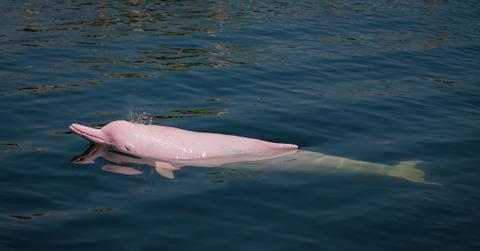Meet the Pink Dolphins Who Call the Amazon River Home
Their unique color isn't the only cool thing about them, either.
Updated Sept. 3 2024, 11:31 a.m. ET

Those lucky enough to visit the Amazon River may think their eyes are playing tricks on them when they spot a boto (AKA: a pink river dolphin) breaching the surface of the water due to their wildly unusual coloring.
Pink river dolphins may sound like something out of a fairy tale, but are very much the real deal, and these pink creatures call the Amazon — as well as river basins in neighboring countries like Ecuador, Bolivia, Columbia, Brazil, and more — home. Keep reading to learn more about pink river dolphins, including what gives them their beautiful blush hue.
Why are pink dolphins pink?
While these pink dolphins are born gray like most other dolphins, as they age they begin to take on the pinkish tone that makes them look so unique. As it turns out, there is actually more than one reason why the boto turn vibrant pink.
First, the sex of a dolphin plays a major role, with male dolphins taking on a much brighter shade than their female counterparts. The experts at the Aqua Expeditions blog say this likely has to do with how aggressively male dolphins play and fight, which produces scar tissue that gives them a decidedly pinker glow.
An individual dolphin's genetics and lifestyle can also make a difference, with things like diet, sun exposure, and the layout of their blood vessels all factoring into things. Some dolphins can even look pinker depending on their moods since dolphins can turn bright pink when they blush, much like an embarrassed or excited person will do!
Pink dolphins are dying in record numbers.
Sadly, these freshwater dolphins are dying off in droves in the Amazon, and experts are racing to find out why. The Guardian reports that scientists are investigating the deaths of hundreds of pink river dolphins who washed up on the shores of Lake Tefé, which is fed by the Amazon River, and the experts believe that a combination of heat and drought is to blame.
They theorize that the lower river levels and increased temperatures — which averaged as much as 10 degrees higher than normal during the dry season — created an inhospitable environment for the dolphins. Thousands of other species have also fallen victim to many manmade conditions that have made nearby waterways completely uninhabitable, including a rise in pollution and a decrease in oxygen levels.
The scientists at the Mamirauá Institute for Sustainable Development are hoping to discover exactly what happened during the recent die-off before the next drought hits so that they can help keep the pink river dolphin populations from dropping too low, as they are amongst only a few other species of freshwater dolphins known to exist in the wild.
The loss of the boto wouldn't just be devastating for the dolphins or sad for those who enjoy witnessing the majesty of the pink dolphins breaching the waters along the Amazon and surrounding areas. It could also spell disaster for all of the other animals who call those waterways home since dolphins play a vital role in helping maintain the ecosystem in these areas.
Hopefully, scientists can figure out how they can help the pink river dolphins before it's too late.
